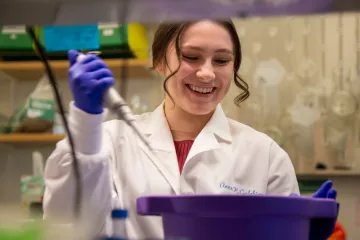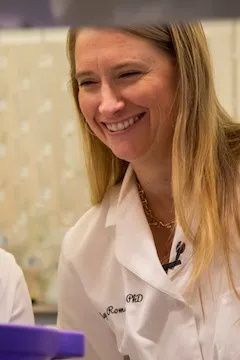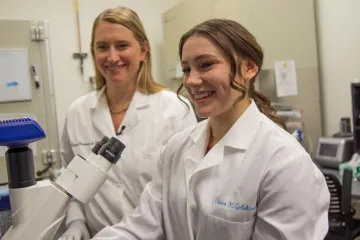Heart researchers stay ahead of the curve by learning cells’ secrets
In the Romanoski Lab, a graduate student simulates blood flow in a petri dish to learn why some people are more susceptible to heart disease.

Anna Golebiewski (left) is a graduate student who, under the mentorship of Casey Romanoski, PhD (right), is investigating how blood primes specific areas of vessels to potentially trigger heart disease.
Anna C. Christensen, College of Medicine - Tucson
Heart disease doesn’t tend to announce itself until it’s been developing for decades. As we age, our hearts and blood vessels change, and risk factors like diet and genetics can lead to plaque buildup in the arteries, making it harder to pump blood through the body — including to the heart itself. With less oxygen to fuel it, the heart slowly weakens.
Despite advances in treating symptoms, such as statin drugs to reduce plaque accumulation, heart disease has been the leading cause of death in the United States since 1950, accounting for around 1 in 5 deaths. Because heart disease begins to develop long before symptoms reveal themselves, John Konhilas, PhD, professor of physiology and member of the Sarver Heart Center, believes scientists need to take a huge step back and pinpoint where things start going wrong.
“There are so many roads to heart disease,” Dr. Konhilas said. “Can we identify and name all the different streets that lead to it?”
Dr. Konhilas is co-director of the Interdisciplinary Training in Cardiovascular and Pulmonary (CVP) Research Program, which has been funded by the National Institutes of Health since 1969 — almost the entirety of the college’s history. Dr. Konhilas points to the Romanoski Lab as an example of a CVP research team that is taking that step back to investigate where the path to heart disease might begin.
“If we can better understand heart disease at the cellular and molecular level, then we can promote a healthy arterial structure,” said Casey Romanoski, PhD, associate professor of cellular and molecular medicine. Her lab is studying endothelial cells, which line the edges of the artery in a single layer. “These cells are the sensors of what’s happening in the blood.”

Anna Golebiewski will begin a fellowship with the American Heart Association after completing her research with the CVP Research Program.
Anna C. Christensen, College of Medicine - Tucson
Anna Golebiewski, a doctoral student in molecular medicine, wants to know exactly how these cells “sense” their surroundings, how they respond to triggers in their microenvironments, and what role they might play in heart disease. And she believes the answer won’t be found by following a straight line, but rather by following along a curve.
Blood vessels throw a curveball
When blood rushes through curves and hairpin turns, such as the aortic arch that sits on top of the heart, it exerts disturbed blood flow patterns upon the endothelial cells. Golebiewski says these cells sense those changes in force, and may respond by releasing inflammatory signals — potentially setting off a feedback loop in which chronic inflammation attracts plaque, itself turning up the volume on inflammation.
“A chronic inflammatory state is going to sensitize the area to plaque development. Inflammatory signals recruit immune cells to clear the buildup, and too much inflammatory signaling can cause the plaque to become necrotic and unstable,” Golebiewski said. “Plaque builds up where vessels are curved. The curvature itself isn’t causing the plaque buildup, but something about the flow patterns created by the curvature sensitizes the area to plaque buildup — in some people much more than others.”
To investigate why some people respond differently to blood taking sharp turns through their vessels, Golebiewski replicates blood flow in a petri dish, with healthy endothelial cells arranged in a single layer and fluid spinning over them.
“I use that device to mimic those two patterns of blood flow — the disturbed blood flow through curves and the uniform blood flow through the straight areas,” she said. “They get the same amount of shear stress applied to them. I’m looking at the way genes are expressed in these cells in response to these patterns.”

Dr. Romanoski says she could
“spend a lifetime” studying
endothelial cells.
Anna C. Christensen,
College of Medicine - Tucson
The cells come from around 150 organ donors in the Los Angeles area, most of whom have passed away in automobile or motorcycle accidents. Before being transplanted into a recipient, tiny samples were saved, giving researchers access to genetically diverse cardiac cells.
“We don’t know who they are. Everything we learn about them, we learn from their DNA and gene levels,” Dr. Romanoski said. “Their cells respond differently to inflammatory situations that we put them in.”
Though they arise from tragedy, these cells may someday help researchers learn more about how heart disease affects people across the globe.
“The more genetically diverse a population is, the more tests we can run and the more we can learn,” Golebiewski said. “So many genetic studies have been conducted on predominantly European ancestry. It’s really exciting to be working with a population that’s more diverse.”
Nurturing the next generation of researchers
Since 1969, the College of Medicine – Tucson has trained around 300 scientists though the CVP Program. More than 90% have gone on to research careers, devoting their lives to unraveling cardiovascular mysteries. Dr. Konhilas says he’s especially proud of the spike in productivity they’ve seen in the past decade.
“We’ve doubled the number of publications as well as grants over the last five years compared to the previous 10 years,” he said. “These types of funding mechanisms wouldn’t exist without institutional support. It’s been integral to getting this grant funded over and over again.”
In recent years, Dr. Konhilas says they have expanded trainees’ access to core resources and improved health insurance options, sent them to important conferences, and guided them through the grant-writing process. Such perks provided a boost to Golebiewski, who recently was awarded a prestigious grant from the American Heart Association, and will become an AHA fellow after completing her current research.
Golebiewski says she’s also grown immensely under Dr. Romanoski’s mentorship.
“I’ve been incredibly lucky to have a mentor who supports my professional and personal goals and makes sure I have everything I need to succeed,” she said.
“Anna has a bright future ahead. I feel so fortunate that she joined my lab,” Dr. Romanoski added. “Research can be slow — a marathon, not a sprint. I get satisfaction from mentoring. I have a lot more control over mentoring than how cells are going to behave. Passing it on to the next generation is really important to me.”
Piecing together the puzzle
For most of us, the hope is that the specialized science performed in labs will someday help us and our loved ones. Though her lab doesn’t develop drugs, Dr. Romanoski shares those dreams.
“Endothelial cells are in all of our tissues and play an important role in diabetes and obesity,” Dr. Romanoski said. “We hope the work we’re doing will have far-reaching consequences beyond heart disease.”

Golebiewski says she benefits from the mentorship of Dr. Romanoski, who has been mentoring students for nearly a decade.
Anna C. Christensen, College of Medicine - Tucson
While the Romanoski Lab’s investigations into how blood affects cells as it careens through the body’s 60,000 miles of vessels might someday inform a search for better pharmaceuticals, for now they’re focused on unraveling the innerworkings of the circulatory system. By building these foundations now, future scientists will have a launchpad for novel research into prevention, treatments and cures.
“Trying to understand how the body works at the cellular level has tremendous potential that we can’t understand yet, because we haven’t discovered how it works,” said Dr. Romanoski, who is also a member of the Sarver Heart Center and the BIO5 Institute. “Basic research is about working together, building knowledge and doing an experiment that no one in the world has ever done before. We might be looking for a specific pattern, or maybe we’ll find a gene that’s never been studied by anyone, it’s just been lurking in the shadows. We don’t even know what we might find — that is really exciting.”
Dr. Konhilas echoes those sentiments.
“We need to understand disease before it becomes a disease. Ultimately, understanding how things work at a basic level will result in some remarkable clinical outcomes,” he said. “I want there to be a major discovery, and we need students to be engaged at the fundamental level of how things work. It always comes back to the physiology of it.”
Golebiewski says that, despite how complicated heart disease is, she gains immense satisfaction from looking at just one piece of the puzzle.
“There are so many facets to this disease. We’re breaking it down to look at one aspect, which is the force from the blood flow on endothelial cells,” she said. “Looking at all the data, the most rewarding thing is realizing that I have accomplished a lot. Even though we don’t have big conclusions yet, the hard work is really going somewhere.”

